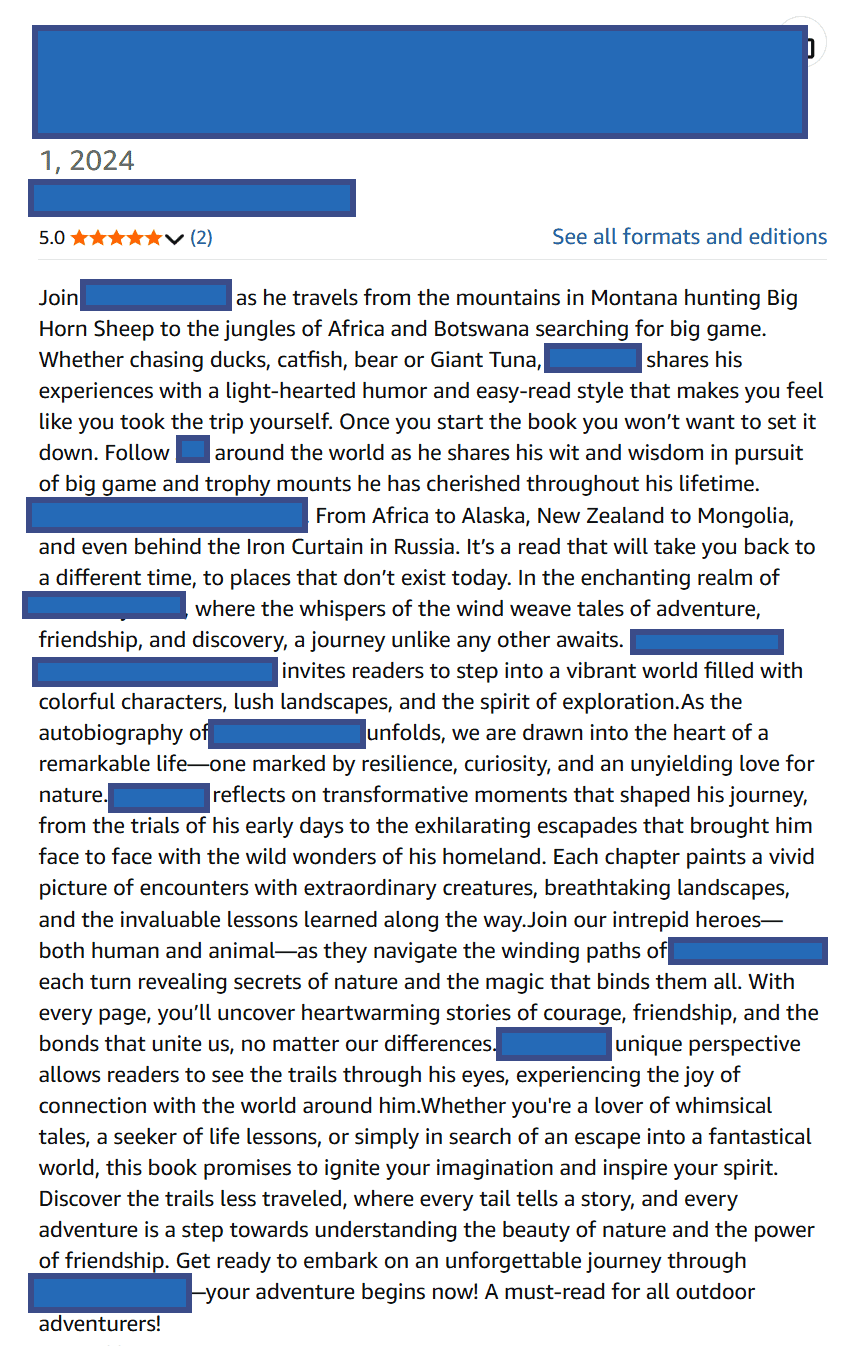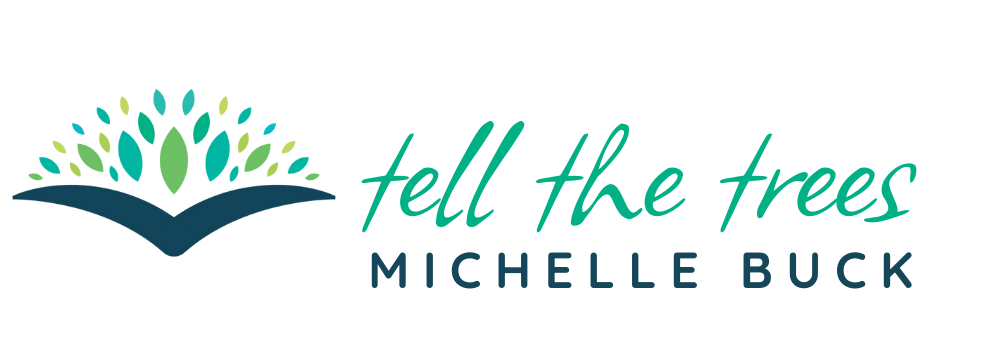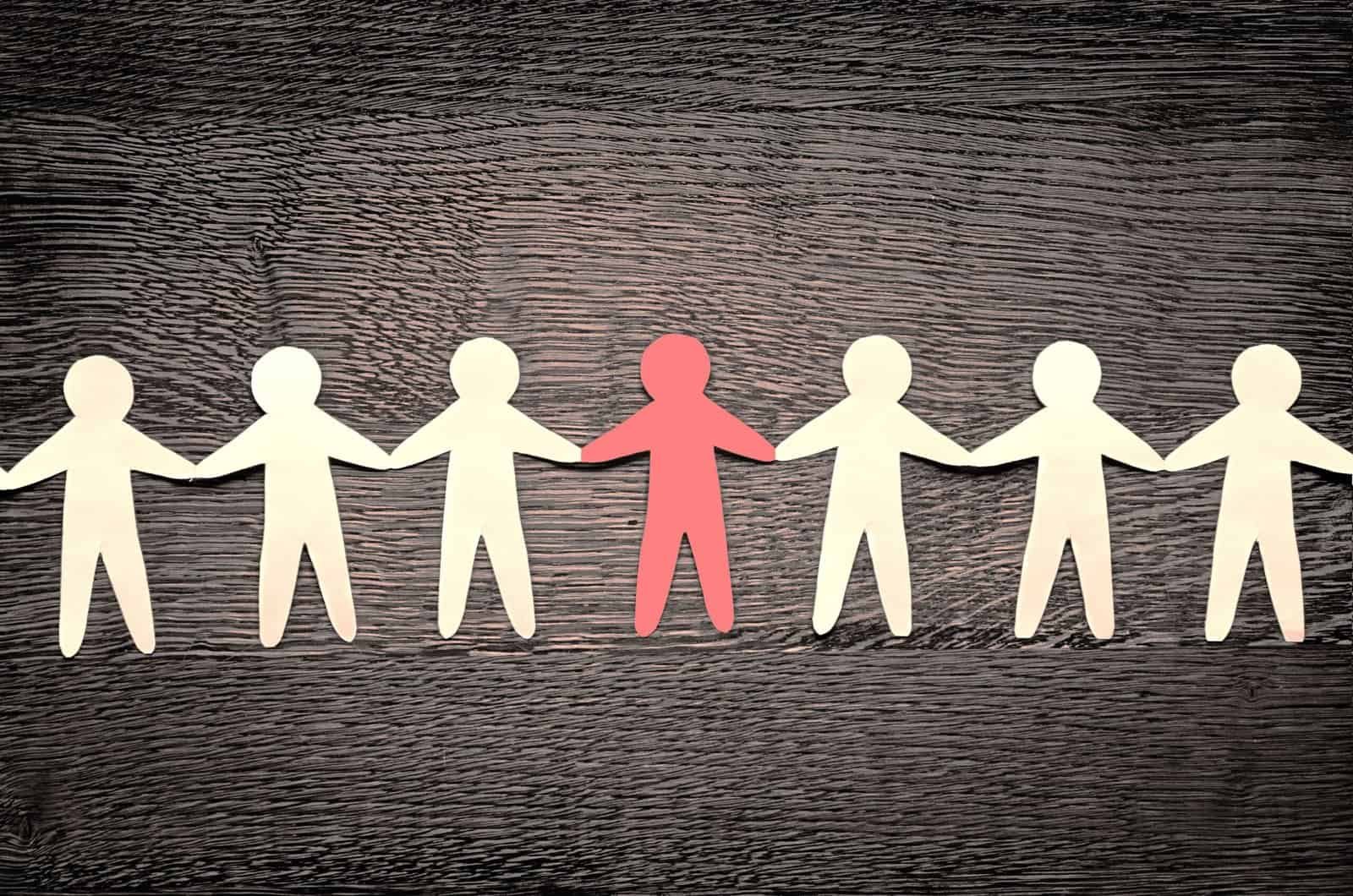by Michelle
Share
by Michelle
Share

Ever wonder why some books take off with book sales while others collect digital dust? When it comes to book marketing, I’ve noticed the same problems pop up again and again. Let me walk you through a real example that perfectly illustrates what NOT to do—and more importantly, how to fix it.
The Post & Ghost Author
Recently, I came across a question that made my marketing brain go into overdrive. An author had been “promoting” his self-published book since October and hadn’t sold a single copy. Not one. Is it bad luck? Or a systematic problem that needs fixing?
When I dug into his book listing, I found a memoir about traveling from Montana to Africa. Sounds interesting enough, right? But I dug a little deeper and uncovered a few problems that I think other authors can easily relate to when it comes to their low book sales.
Here’s the Amazon book description with the name of the book and the author blacked out. Notice how many times his name or the book name is mentioned here. We’ll get into this, but at first glance, that’s a lot!

Problem #1: The Blurb is All About YOU (And Nobody Cares)
The biggest mistake I see authors make is treating their book description like a personal diary entry. This author’s blurb went on and on about his adventures, his travels, his experiences hunting bighorn sheep and tracking game across continents.
Read any marketing book or blog post and you’ll quickly learn this lesson: Readers don’t buy books to learn about random strangers. They buy books to get something for themselves. You may have heard this stated as “providing value to your readers.” And the same is true of books, not just your website or blog posts.
Instead of: “Follow [name] as he travels from Montana hunting bighorn sheep…”
Try: “Want to experience the raw thrill of hunting giant tuna off Africa’s coast? Ready to track bighorn sheep through Montana’s unforgiving peaks?”
See the difference? One focuses on the author, while the other focuses on what the reader will gain. That simple copywriting shift can be the reason a visitor stops their scroll to learn more about your book.
Problem #2: Genre Identity Crisis
This poor book couldn’t decide what it wanted to be when it grew up. The blurb started with realistic hunting locations, then suddenly veered into “enchanting realms” and “whimsical tales.”
Pick a lane and stay in it. Are you writing a hunting memoir or a fantasy adventure? Your readers need to know what they’re signing up for.
Anyone looking at your book or the description needs to know that right away, so don’t confuse them with varying descriptions.
Problem #3: Burying Your Book Benefits
All the good stuff—the life lessons, the inspiration, the adventure—was buried at the end of this massive blurb. That’s like hiding your best-selling products in the basement.
Lead with benefits, not backstory. Tell readers upfront what they’ll gain from your book.
Speaking of benefits, there is a difference between features and benefits. A simple test is to ask yourself, what is it? This will tell you the features. If you want to know the benefits, ask yourself, what’s in it for me? Again, you want to think like your reader. Instead of just listing the features of the book, make sure you are highlighting the best benefits and what the reader will get out of the book.
Here’s an example:
- Feature: “This 200-page guide contains 15 chapters on Pinterest marketing strategies.”
- Benefit: “You’ll finally stop wasting time on Pinterest and start driving real traffic to your website.”
If you want to highlight the features and benefits, use this magic formula:
Feature + “which means” + Benefit
Example: “This book includes step-by-step screenshots (feature) which means you’ll never get lost or confused while setting up your Pinterest account (benefit).”
The classic saying in marketing is: “People don’t buy a drill because they want a drill—they buy it because they want a hole in the wall.” Your book’s “hole in the wall” is the transformation or solution you’re promising your reader.
Features inform, but benefits sell. Always lead with the benefit, then support it with features if needed.
The Keywords Problem & It’s Impact on Book Sales
If you’re getting zero book sales, your keywords are probably the real culprit. You could have the most brilliant book ever written, but if people can’t find it, it might as well not exist.
I always recommend using Publisher Rocket to research your keywords, then weaving them naturally throughout your book description. Don’t just guess at what people are searching for—find out for sure.
Keywords are important to use in titles, metadata, your book cover blurb, and, of course, your product book description on Amazon or other platforms. If someone is searching for your book, how will they find it if you aren’t using keywords? Think about how you search for books on Amazon. In the example above, the author is using his name and the book name throughout the book description. In my humble opinion, he’d be better off using keywords and highlighting those search terms instead.
Take the time to find the right keywords and use them appropriately. This alone could be the driving factor to increase your book sales.
Book Sales Income Expectations
Let’s have an honest conversation about money. I get asked all the time whether you can make a living from self-publishing. The short answer? Probably not from your first book.
I’ve written three books about Pinterest marketing and personal branding, and while they provide supplemental income, I don’t rely on them as my primary revenue source. With less than 500 email subscribers, I’m still in the audience-building phase of my business.
Here’s what successful nonfiction authors actually do:
- They write a series of books—Look at Dale Roberts. He has books on self-publishing, writing on Amazon, using YouTube as an author, and going wide. When readers buy one, they often buy the whole set.
- They build an audience first – If I could do it over, I’d focus on growing my email list before writing my first book. It’s much easier to sell to people who already know and trust you.
Another type of book that seems to get a lot of book sales is the low content books. I personally think Amazon is over-saturated with these books, but if you just want to use writing for an income generation tool, then that might be the way to go.
KDP Select vs. Going Wide
Another common question I get is about Amazon’s KDP Select program. Here’s the deal:
KDP Select gives you:
- Higher royalty rates (around 60% vs. 35-40%)
- Inclusion in Kindle Unlimited
- Access to promotional tools
- But you’re locked into Amazon exclusively for 90 days
Going wide means:
- You can sell on multiple platforms (Draft2Digital, Apple Books, Google Play)
- You’re not putting all your eggs in one basket
- But you miss out on some Amazon benefits
My take? Don’t abandon Amazon entirely (they have the biggest audience), but consider going wide to maximize your reach. If this topic interests you, please be sure to read my series on going wide.
How Can You Get More Book Sales?
If your book isn’t selling, start with these three fixes:
- Rewrite your blurb to focus on reader benefits, not your personal story
- Research and optimize your keywords using tools like Publisher Rocket
- Compare your book cover to successful books in your genre
Every time you write a book, you’re learning something new. Don’t expect to hit a home run on your first swing. Focus on building your audience, improving your craft, and treating each book as a stepping stone rather than a lottery ticket.
The self-publishing game is all about playing the long game. Stay consistent, keep learning, and most importantly, write books that give readers something they actually want.
Thank you to Liza, Michelle, Richard, and Karen for the questions!
What’s your biggest self-publishing challenge? Drop me a line—your question might be featured in my next Q&A session!
Tell the Trees is supported by its readers. When you make a purchase using links on this site, it may result in affiliate commission. Please visit my affiliate disclosure page for more information.
Let's Discuss It
The EU Accessibility Act officially kicked in on June 28, 2025, and that means it's being enforced right now. Here's what to expect for self-publishing.
Sometimes what we call perfectionism is just fear of rejection in disguise. We keep our work hidden because putting it out there means people can judge it.
D2D for print books will not replace Amazon KDP for most authors—the royalty difference is just too significant if you're primarily selling direct to consumers online. But it's not supposed to replace Amazon; it's supposed to complement it.
Here’s a statistic that might make your stomach drop: the average book sells around 250 copies in its lifetime. Yep, you read that right. And if you don’t have an email list or a solid foundation in place, your book is likely headed straight for that unfortunate average. I’ve watched countless authors spend thousands of








